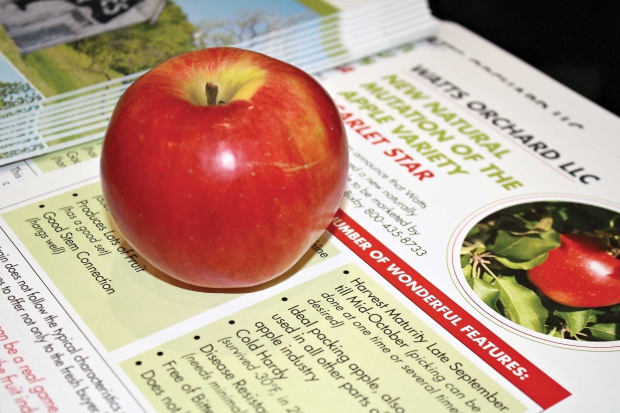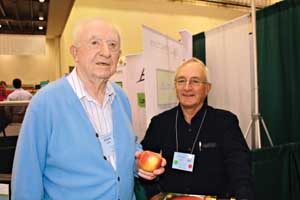
Scarlet Star is being offered to growers by Stark Bro’s, which will add it to its catalog this year. Richard Lehnert/Good Fruit Grower
Stark Bro’s Nurseries and Orchards Company is testing a new apple, named Scarlet Star, that was discovered as a whole-tree mutation in an orchard in Howard City, Michigan.
It was found about six years ago by Wayne Watts, who owns the orchard and farm market where it was discovered. He’s been observing the tree since then. Stark is putting trees in its scion block and making some trees, many of them for Watts, who wants to increase the tree in his own orchards. He will make a planting this spring.
Stark, based in Louisiana, Missouri, will list the variety in next year’s catalog, according to Shawn Bixby, who works in commercial sales for Stark. Bixby and Watts were showing off the new apple at the Stark booth at the Great Lakes Fruit, Vegetable, and Farm Market Expo in December 2014.
Neither Watts nor Bixby can figure out why the tree appeared in a planting of Northern Spy, but the tree somehow began gradually changing into a very un-Spy-like tree, now retaining just one Northern Spy limb.
“It’s kind of a different apple,” Bixby said.
A lot of testing still needs to be done, he said, but it appears to have several good attributes.
The bright red, shiny apple has a sweet and tart flavor with high juice content, and good firmness and storability.

Wayne Watts, left, found Scarlet Star in his Northern Spy orchard six years ago. Richard Lehnert/Good Fruit Grower
It is productive and produces annually, unlike its parent Northern Spy, which has a biennial bearing tendency. It has a good stem connection and hangs well, Watts said.
Harvest maturity is late September to mid-October, and picking can be done once or several times, Watts said.
It may have potential for slicing.
The tree survived the hard Michigan winter of 2014, when temperatures in that orchard fell to -30˚F, and it produced a full crop in 2014. Watts says it appears not to be susceptible to scab and has been, so far, free of bitter pit.
The skin color does not bleed in.
Bixby has arranged for 25 trees to be sent to Phil Schwallier, the extension tree fruit educator on Fruit Ridge, north of Grand Rapids, Michigan. Schwallier says he knows very little about the apple but will plant some at the Clarksville Horticultural Experiment Station and perhaps two other locations.






Leave A Comment